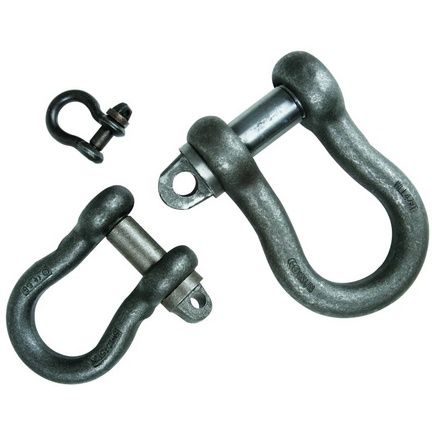Introduction
In the realm of heavy lifting and material handling, the synergy between lifting slings and shackles plays a pivotal role in ensuring safety, efficiency, and reliability. These essential components form a crucial connection point in various industries, ranging from construction and manufacturing to maritime and oil and gas. In this comprehensive exploration, we delve into the design, applications, benefits, and considerations associated with lifting slings and shackles.
Lifting Slings: The Foundation of Vertical Transport
Lifting slings are flexible, load-bearing straps used to secure and lift heavy loads. They come in various materials, including nylon, polyester, chain, and wire rope, each tailored to specific lifting requirements. The choice of material depends on factors such as load weight, environmental conditions, and the desired level of flexibility.
-
Nylon and Polyester Slings: These synthetic slings are lightweight and flexible, making them ideal for delicate loads. Nylon slings are known for their stretchability, providing shock absorption during lifting. Polyester slings, on the other hand, offer excellent resistance to chemicals and abrasion.
-
Chain Slings: Composed of linked metal chains, chain slings are robust and durable, suitable for heavy-duty lifting operations. They are resistant to high temperatures, making them ideal for use in foundries and steel mills.
-
Wire Rope Slings: Constructed from strands of steel wire, wire rope slings offer strength and durability. They are well-suited for lifting loads with sharp edges and are resistant to abrasion and crushing.
The Versatility of Lifting Slings
Lifting slings are versatile tools that find applications in a wide range of industries:
-
Construction: Lifting slings are integral to construction projects, facilitating the movement of heavy building materials, steel beams, and other construction components.
-
Manufacturing: In manufacturing settings, lifting slings are used to transport raw materials and finished products within facilities, streamlining production processes.
-
Maritime Operations: On ships and offshore platforms, lifting slings are crucial for hoisting and positioning heavy equipment and cargo.
-
Oil and Gas Industry: Lifting slings play a vital role in the extraction and transportation of oil and gas equipment, ensuring efficient and safe operations in challenging environments.
Understanding Shackles: The Anchors of Lifting Systems
Shackles, the unsung heroes of lifting operations, serve as the vital link between lifting slings and the load. They come in various types, each designed for specific applications, and are characterized by their U-shaped body and pin for secure attachment.
-
Bow Shackles: Recognizable by their larger, rounded shape, bow shackles are suitable for multi-dimensional loads. Their rounded design allows for greater sling articulation.
-
D-Shackles: With a more compact, D-shaped body, these shackles are ideal for single-direction loads. Their design provides increased stability and reduced sway during lifting.
-
Screw Pin Shackles: Featuring a removable pin that can be easily screwed in and out, these shackles are user-friendly and convenient for quick attachment and detachment.
-
Bolt-Type Shackles: Secured with a bolt and nut, these shackles offer additional security, making them suitable for critical lifting applications.
The Symbiotic Relationship
The connection between lifting slings and shackles is symbiotic, with each component complementing the other to create a robust and reliable lifting system. Lifting slings provide the flexibility and load-bearing capacity, while shackles ensure a secure attachment point to the load. This collaboration is essential for maintaining safety, especially in dynamic lifting scenarios where loads may shift or change direction.
Benefits of Lifting Slings and Shackles
-
Flexibility and Adaptability: Lifting slings, with their various materials and configurations, offer flexibility to adapt to different load shapes and sizes. Shackles, with their swiveling design, accommodate changes in load angles, providing a versatile and adaptable lifting system.
-
Strength and Durability: The combination of durable lifting slings and robust shackles ensures the strength needed to handle heavy loads. This strength is crucial for withstanding the challenges of demanding lifting environments.
-
Safety and Load Distribution: Lifting slings distribute loads evenly, reducing the risk of concentrated stress points. Shackles contribute to this by providing a secure connection point, preventing slippage or detachment during lifting operations.
-
Efficiency and Ease of Use: The efficiency of lifting operations is enhanced by the ease of use offered by lifting slings and shackles. Quick and secure attachment and detachment contribute to operational efficiency, saving time and effort.
Considerations for Optimal Performance
While the benefits of lifting slings and shackles are substantial, certain considerations are vital for optimal performance and safety:
-
Proper Sizing: Ensure that both the lifting slings and shackles are appropriately sized for the intended load. Undersized equipment may compromise safety, while oversized equipment can reduce efficiency.
-
Regular Inspection: Periodic inspection of lifting slings and shackles is crucial to identify signs of wear, damage, or deformation. Damaged components should be promptly replaced to maintain safety standards.
-
Compliance with Standards: Verify that lifting slings and shackles meet industry standards and regulations. Compliance ensures that the components are designed and tested to withstand specific loads and conditions.
Conclusion
In conclusion, the collaboration between lifting slings and shackles forms the backbone of safe and efficient lifting operations. The versatility, strength, and adaptability of these components make them indispensable in various industries. By understanding the benefits and considerations associated with lifting slings and shackles, professionals can make informed decisions, promoting safer and more effective lifting practices. Whether in construction, manufacturing, maritime, or the oil and gas industry, the power of lifting slings and shackles lies in their crucial connection, ensuring that heavy loads are lifted with precision, reliability, and safety.


No comments yet